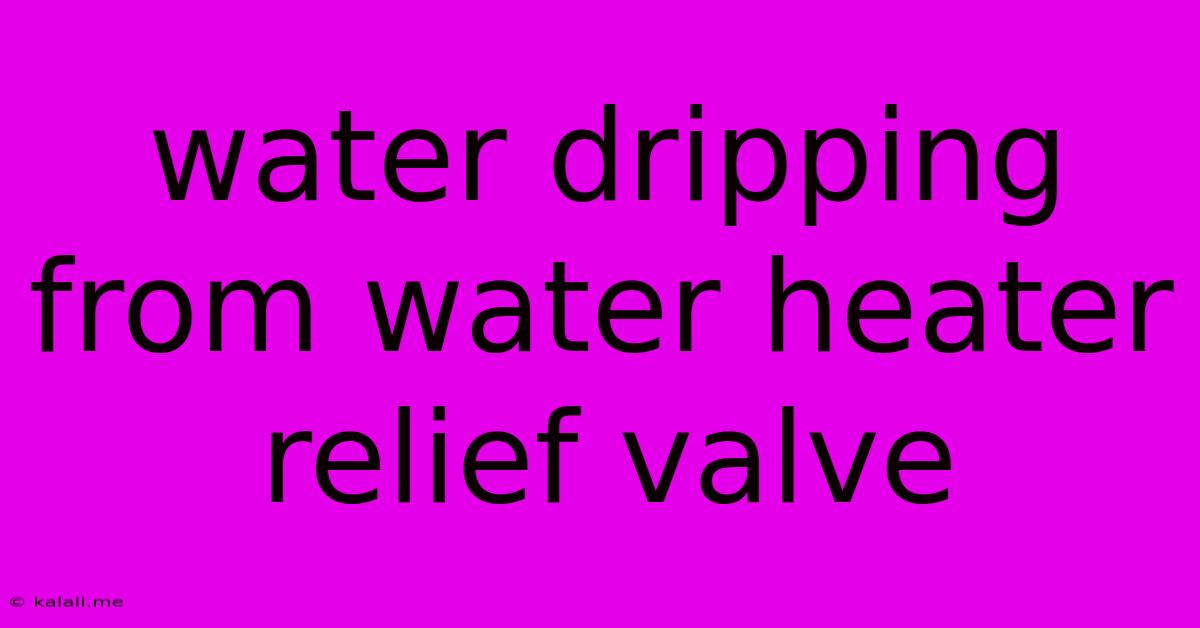Water Dripping From Water Heater Relief Valve
Kalali
Jun 02, 2025 · 4 min read

Table of Contents
Water Dripping from Water Heater Relief Valve: Causes and Solutions
A dripping water heater relief valve might seem like a minor inconvenience, but it's actually a sign that something isn't right with your water heater. Ignoring this leak can lead to more serious problems, including water damage, increased energy bills, and even a potential safety hazard. This article will delve into the common reasons why your water heater relief valve is dripping, and offer solutions to fix the problem. Understanding the cause is key to preventing future leaks and ensuring the longevity and safety of your water heater.
Understanding Your Water Heater Relief Valve
Before diving into troubleshooting, it's crucial to understand the function of the temperature and pressure relief valve (T&P valve). This safety device is designed to release excess pressure and temperature from your water heater, preventing dangerous explosions. If the pressure inside the tank builds up too high—perhaps due to overheating or a malfunctioning pressure regulator—the T&P valve opens, releasing hot water to relieve the pressure. A slight drip after the valve has relieved pressure is normal, but a consistent drip is a cause for concern.
Common Causes of a Dripping Water Heater Relief Valve
Several factors can contribute to a constantly dripping water heater relief valve. Let's examine some of the most frequent culprits:
- Excess Pressure: This is the most common cause. The pressure in your water heater can build up due to several reasons, including a faulty pressure relief valve itself, a malfunctioning pressure regulator, a problem with your home's water supply, or simply a build-up of sediment inside the tank.
- Faulty T&P Valve: The valve itself might be worn out or damaged, failing to seal properly even when the pressure is normal. Mineral deposits and corrosion can also interfere with the valve's operation.
- Temperature Issues: While less common, an excessively high water temperature can also trigger the T&P valve to drip. This could indicate a problem with the thermostat, heating element, or even improper installation.
- Sediment Buildup: Over time, sediment accumulates at the bottom of the water heater tank. This sediment can restrict water flow, leading to increased pressure and triggering the relief valve.
- Expansion Tank Issues (if applicable): If your home uses an expansion tank to manage water pressure, a malfunctioning or insufficient expansion tank can cause excessive pressure within the water heater system.
Troubleshooting and Solutions
Addressing a dripping water heater relief valve requires careful investigation. Here's a step-by-step approach:
- Check the Water Pressure: Use a pressure gauge to measure the water pressure at a cold water tap. High pressure indicates a potential problem with your home's plumbing system that needs attention from a qualified plumber.
- Inspect the T&P Valve: Look for any visible signs of damage, corrosion, or mineral deposits on the valve. A simple visual inspection can sometimes reveal the source of the problem.
- Test the Valve (with caution): Carefully lift the T&P valve lever slightly. Hot water may spurt out, so be extremely cautious. The valve should close fully and stop dripping once the lever is released. If it continues dripping, the valve is likely faulty and needs replacement.
- Flush the Water Heater (if applicable): If there's significant sediment buildup, flushing the water heater can help reduce pressure and improve its efficiency. This process involves draining some or all of the water from the tank. (Remember to turn off the power and gas supply first).
- Consider Professional Help: If you've tried these steps and the dripping persists, it's best to call a qualified plumber. They can diagnose the underlying issue and recommend the appropriate solution, which may include replacing the T&P valve, repairing the pressure regulator, or addressing other plumbing problems.
Prevention is Key
Regular maintenance is crucial to preventing a dripping water heater relief valve and ensuring the longevity of your water heater. This includes:
- Annual Inspection: Have a qualified professional inspect your water heater annually to identify and address potential problems early on.
- Regular Flushing: Flushing your water heater every few years can help remove sediment buildup and maintain optimal performance.
Ignoring a dripping water heater relief valve can be risky. By understanding the potential causes and taking the appropriate steps, you can prevent further damage and ensure the safety and efficiency of your hot water system. Remember, safety should always come first. If you're unsure about any step, it's always best to consult a licensed plumber.
Latest Posts
Latest Posts
-
Use Of For In A Sentence
Jun 04, 2025
-
Roots Forming A Number In Logo
Jun 04, 2025
-
Sourdough Starter Separating Liquid On Top
Jun 04, 2025
-
How To Cats Play With Their Food
Jun 04, 2025
-
How To Adjust Shower Mixing Valve
Jun 04, 2025
Related Post
Thank you for visiting our website which covers about Water Dripping From Water Heater Relief Valve . We hope the information provided has been useful to you. Feel free to contact us if you have any questions or need further assistance. See you next time and don't miss to bookmark.